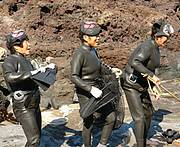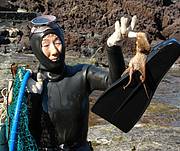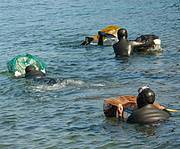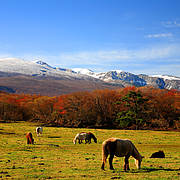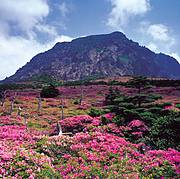Mermaids face extinction
01 April 2012 | Article
By Célia Zwahlen. People recognize them by the long whistling sound they make when they surface from the sea to breathe. They are exclusively female. On firm ground, they become like the rest of us, blending in while they work the land. But every 15 days the sea calls them back.
Where they are from, they are known as haenyeo. A breed of women who, for centuries, have gone free-diving year round to provide for their families. Their origin? Jeju Island in South Korea, home of the next IUCN World Conservation Congress.
Picking shellfish or seaweed from the bottom of the sea, mothers and daughters have succeeded themselves for generations. The most agile divers – often the leaders of the pack – can swim down 20 metres and hold their breath for about two minutes.
Jeju’s haenyeo brave the waters by rain, snow or sunshine, so long as the tidal conditions are right. The moon decides their working days. They learnt the hard way that the sea must be treated with humility. In their trade, greed means death.
Natural resilience
Today, the mermaids wear rubber suits. But until 40 years ago, a light cotton garment was all that covered them. This meant they could dive for barely an hour before the cold started to bite. They would then gather in a ritual around the fire until they were warm enough to start again. Now they are able to dive for three to eight hours straight depending on the season, still without using air tanks. Yet the fruit of their labour is becoming less abundant.
“The most highly skilled haenyeo can earn up to US$ 30,000 a year, which goes a long way in Jeju. But earnings are diminishing, they say, as quickly as the sea products are being destroyed by environmental pollution,” said Korean-American author Brend Paik Sunoo at a presentation of her book ‘Moon Tides: Jeju Island Grannies and the Sea’.
The women sea divers understand natural cycles to maintain a healthy fish population. Each village on the island has its own haenyeo association and part of its function is to manage the oceanic environment. Harvest is forbidden during the egg-laying season. When haenyeo get older, they care for the seabed, clearing out trash and rooting out bad seaweed. But against the world’s wider ocean pollution they can do nothing.
Time for change
Now with fewer fish in the sea, it seemed the right time to end the lineage. We are witnessing the last of a tradition first recorded in 1079. But haenyeo have little regret that their daughters won’t carry their steps. Instead they are proud of the sacrifices they made to send their offspring to college.
Most of these women didn’t become sea divers by choice: the trade was passed on to them by their mothers or grandmothers, and their lack of education meant they had no other opportunities. As soon as exports to Japan were authorized in the 1970s, increasing their revenue, they grabbed this chance as the first door out of centuries of hard labour. Because even if the money is good, is it worth risking your life for?
Hence, less than 5,000 haenyeo remain today, against 23,000 in 1966. They are aged between 39 and 93, and roughly 40% of them are 70 or above. In an effort to keep their legacy, Jeju saw the creation of a haenyeo museum and a haenyeo diving-school in recent years.
Many ask why Jeju women dive and not men. Biologically, the female body seems more adapted to withstand cold temperatures and high water pressure. But there is also a social explanation. In Korea, it is a disgrace to show your body. So if your job requires you to be practically nude, it puts you at the lowest rank of society. In a culture where women are seen as inferior, men did not want this role for themselves.
A formidable team
But for women it meant independence. The haenyeo have been time and again at the centre of their communities, weaving a matriarchal net even in the midst of Confucian society. At home they respect traditions and take the role of submissive wives. But among themselves they are close-knit, competitive, self-sufficient and organized, and their collective efforts shape Jeju society.
On several occasions, their strong will single-handedly changed the social, economic and cultural landscape of the island. During Japanese occupation, for example, they drove one of the strongest opposition movements in all of Korea.
Reversed parenting roles have been apparent since the 19th century, when a ban forbidding women to leave Jeju was lifted. Many haenyeo travelled, sometimes as far as Russia, leaving husband and children alone for long periods.
Respect for nature
They take an active part in shamanic rituals (the locals believe 18,000 gods dwell on the island). “At the core of shamanic belief, there is a respect for nature and the belief that spirit resides in everything,” explains Brend Paik Sunoo. Such traditions feed hope in the face of violent winds and razor-sharp rocks for village people who, until recently, largely depended on the haenyeo for their livelihood.
Haenyeo are also greatly involved in supporting their communities through voluntary work. Some groups set up contribution funds to help people in need. Allocated diving areas exist solely for the purpose of financing schools. Without a doubt, they are committed to making life easier for their peers and for future generations.
The existence of haenyeo shows beautifully how a society can organize itself around whom is able to reap natural resources. When it comes to governing nature’s use and sharing its benefits equitably, we can take many lessons from them.
One day soon, they too like mermaids will be recounted as myth. We must remember them, but not cry. Instead let’s glorify their selfless determinism, for the women of the sea have taken the reins of their own destiny.
